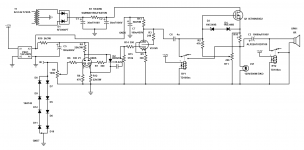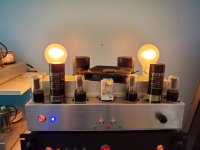Rig it up in a circuit with a light bulb. If it's a real depletion mode part, typing gate to source will turn it on. if it's enhancement it would be off, no?
thank you, will try that...
Ok. The 500W bulbs arrived.
With 300W and ~25V @ drain I get 1.3A of current.
With 500W and ~25V @ drain I get 2.4A of current.
The amp seems to put out more clean power with the 300W bulb and lower current so that's what I'm going with.
Here's the current schematic which now uses a 6V6 cathode follower. The HF response is improved!
With 300W and ~25V @ drain I get 1.3A of current.
With 500W and ~25V @ drain I get 2.4A of current.
The amp seems to put out more clean power with the 300W bulb and lower current so that's what I'm going with.
Here's the current schematic which now uses a 6V6 cathode follower. The HF response is improved!
Attachments
Out of curiosity, What would be an appropriate inductance if I was to try and choke load it instead?
1mH? Am I close?
Thanks everyone!
1mH? Am I close?
Thanks everyone!
An inductor increases distortion (if that matters). Find some resistors and give the bulbs to the needy.
I was in the same boat until I realised that a constant current source made from a transistor or two is often a better choice than an inductor (smaller, cheaper, more linear). Nelson Pass has a few CCS suggestions in his papers.Out of curiosity, What would be an appropriate inductance if I was to try and choke load it instead?
1mH? Am I close?
Thanks everyone!
Oh, 1 mH seems like way too low, but I didn't do the math.
Ya I'm starting to think a CCS would be easier. I could even use a second pair of the same MOSFETs... 1mH might work for the PS filter though instead of 1R.
If the inductance was below the source (see the MoFo thread) you need upwards of 30 mH depending on how low you want to go in frequency. With the inductance above the drain, the impedance is much higher, extremely high in your case as you have no local feedback, and it only becomes practical if you can use a centre-tapped choke (e.g. the primary of a 115+115 power transformer) in balanced mode, where you can get tens or hundreds of Henries.
A CCS works well but you don't get the extra voltage swing and efficiency is still half of an inductor loaded output. That then evolves to a modulated CCS where the sum of the current in the top and bottom halves is kept constant. It is then effectively operating push-pull but without the second harmonic cancellation as the input signal only drives one half. The ALPHA Nirvana on this forum is one example.
A CCS works well but you don't get the extra voltage swing and efficiency is still half of an inductor loaded output. That then evolves to a modulated CCS where the sum of the current in the top and bottom halves is kept constant. It is then effectively operating push-pull but without the second harmonic cancellation as the input signal only drives one half. The ALPHA Nirvana on this forum is one example.
Ya?
Today I got finally 120V 300W bulbs. I had to drive over 100 km round trip to get them - Seems Sylvania doesn't sell them in Canada anymore.
The amp is improved with them though.
Next my idea will be to swap the MOSFET and the bulb to make it a source follower. I think that will lower the Zout and the input capacitance, yes?
Today I got finally 120V 300W bulbs. I had to drive over 100 km round trip to get them - Seems Sylvania doesn't sell them in Canada anymore.
The amp is improved with them though.
Next my idea will be to swap the MOSFET and the bulb to make it a source follower. I think that will lower the Zout and the input capacitance, yes?
Oh so after some messing around, blowing up some parts, and trying to make it sound better, I've changed the MOSFETs and made it into a source follower with 500W light bulb loads...
I also added some diodes to kill transients from the tube preamp that drives it (killed two MOSFETs yesterday even with the zeners...)
It's a pretty nice sounding amp if I do say so myself!
I had to add a fan because the heatsink was hitting 80c...
The 6V6 tubes are old Lowrey's I pulled from an old organ in the trash 15 years ago LOL
I also added some diodes to kill transients from the tube preamp that drives it (killed two MOSFETs yesterday even with the zeners...)
It's a pretty nice sounding amp if I do say so myself!
I had to add a fan because the heatsink was hitting 80c...
The 6V6 tubes are old Lowrey's I pulled from an old organ in the trash 15 years ago LOL
Attachments
Last edited:
OK - so you asked for help...

This way you don't need big light bulbs/big output caps/big heatsinks.
But yes, the output source follower is class AB...
D.

This way you don't need big light bulbs/big output caps/big heatsinks.
But yes, the output source follower is class AB...
D.
Thanks! It just so happens I have the MOSFETs for this. What are the values of the resistors between the MOSFETs? Too small for me to read 🙂
I'm thinking of designing something using these MOSFETs in source follower with transformer output.
I've gone back to 300W bulbs in the mean time. Less wasted heat and such for a marginal difference in output 🙂
I'm thinking of designing something using these MOSFETs in source follower with transformer output.
I've gone back to 300W bulbs in the mean time. Less wasted heat and such for a marginal difference in output 🙂
FYI I just played with a power meter...
This amp using 300W bulbs from Sylvania, and 72V B+ with 27V across the MOSFET results in a draw of 315W from the wall, and a PF of 0.8. Using 500W bulbs in place with the same voltages requires 405W from the wall... Another 50W dumped into the bulbs, and another 25W into the heatsink.
In the 300W form, the standing current is 1.6A per side @ 27V for 43W dissipation per side. Surprising how much more surface and material you need to dissipate that heat without a fan and heat pipes. I'm not used to SS except for CPUs and the like. Tubes have their own "heatsink" 🙂
This amp using 300W bulbs from Sylvania, and 72V B+ with 27V across the MOSFET results in a draw of 315W from the wall, and a PF of 0.8. Using 500W bulbs in place with the same voltages requires 405W from the wall... Another 50W dumped into the bulbs, and another 25W into the heatsink.
In the 300W form, the standing current is 1.6A per side @ 27V for 43W dissipation per side. Surprising how much more surface and material you need to dissipate that heat without a fan and heat pipes. I'm not used to SS except for CPUs and the like. Tubes have their own "heatsink" 🙂
- Home
- Amplifiers
- Solid State
- Any help? First attempt at a "hybrid" using depletion MOSFETS


